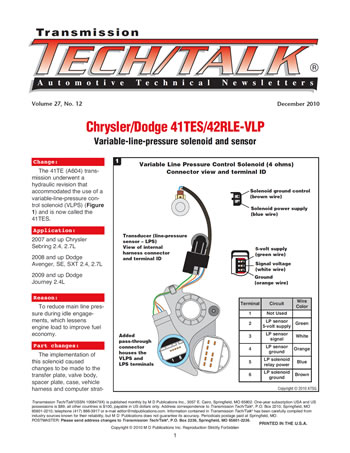


The 41TE (A604) transmission underwent a hydraulic revision that accommodated the use of a variable-line-pressure control solenoid (VLPS) (Figure 1) and is now called the 41TES.

- 2007 and up Chrysler Sebring 2.4, 2.7L
- 2008 and up Dodge Avenger, SE, SXT 2.4, 2.7L
- 2009 and up Dodge Journey 2.4L

To reduce main line pressure during idle engagements, which lessens engine load to improve fuel economy.

The implementation of this solenoid caused changes to be made to the transfer plate, valve body, spacer plate, case, vehicle harness and computer strategy to facilitate the use of this solenoid. It also introduced the use of a pressure transducer to monitor the VLPS.
Case: The case was changed to accommodate an additional pass-through connector for the VLPS and transducer mounted on the valve body (Figure 1).
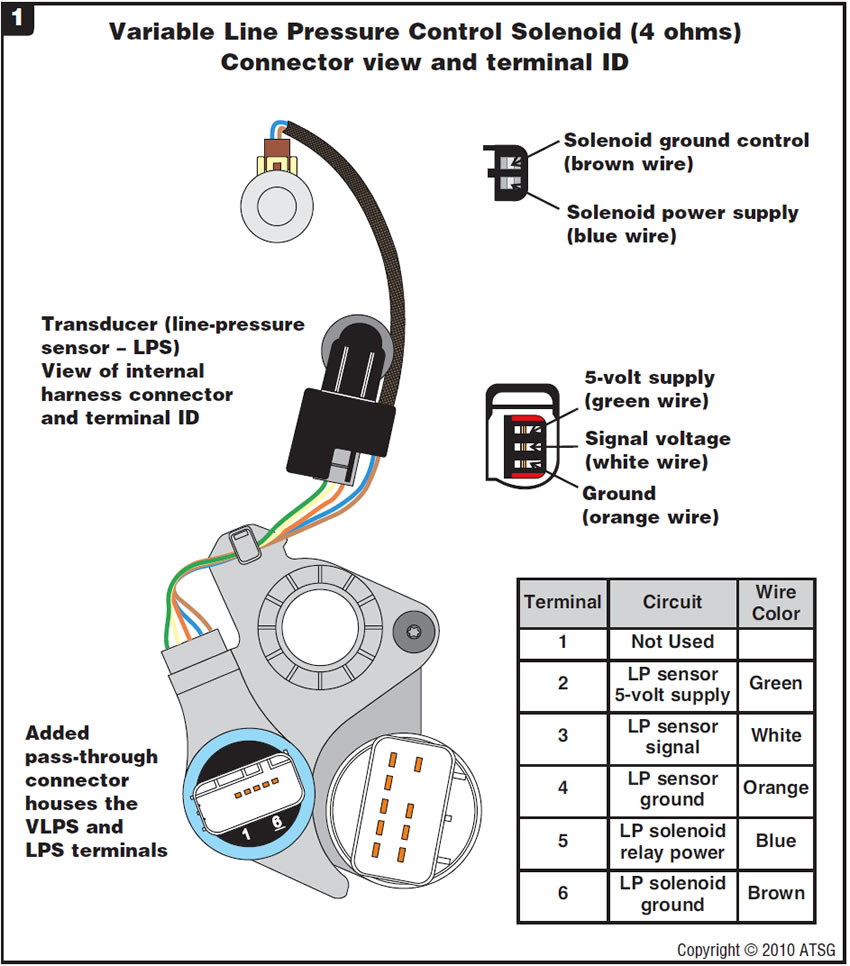
Vehicle harness: An additional connector was added to the vehicle harness to the transmission to accommodate the added pass-through connector mounted on the valve body. The harness plugging into the PCM contains the added wiring for the VLPS and transducer (Figure 1).
PCM: The PCM is programmed with a strategy to operate the solenoid under various conditions to reduce line pressure. It also observes the transducer to monitor and tailor solenoid operation.
Valve body: Changes were made to the casting of the valve body to provide the fitting of the solenoid and transducer as well as passages for the hydraulics allowing the solenoid to influence the pressure-regulator valve (Figure 2).
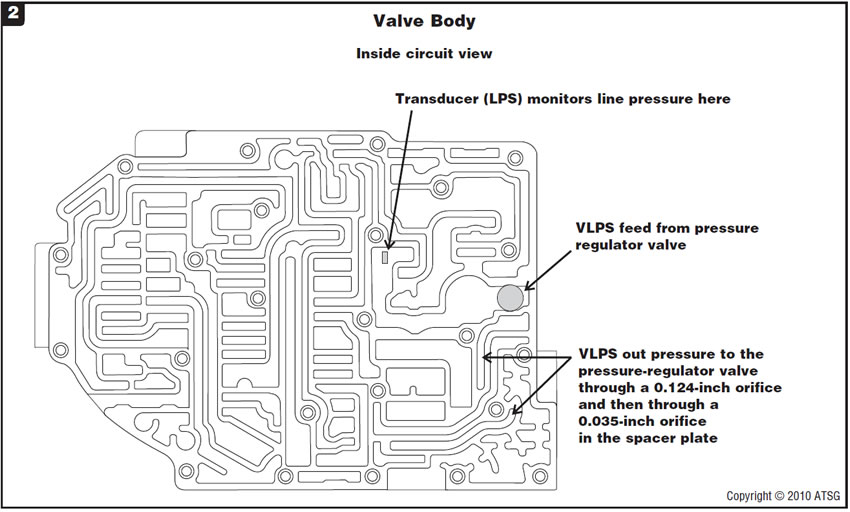
Spacer plate: Changes were made to the spacer plate by the addition and changes to orifices within the plate (Figure 3).
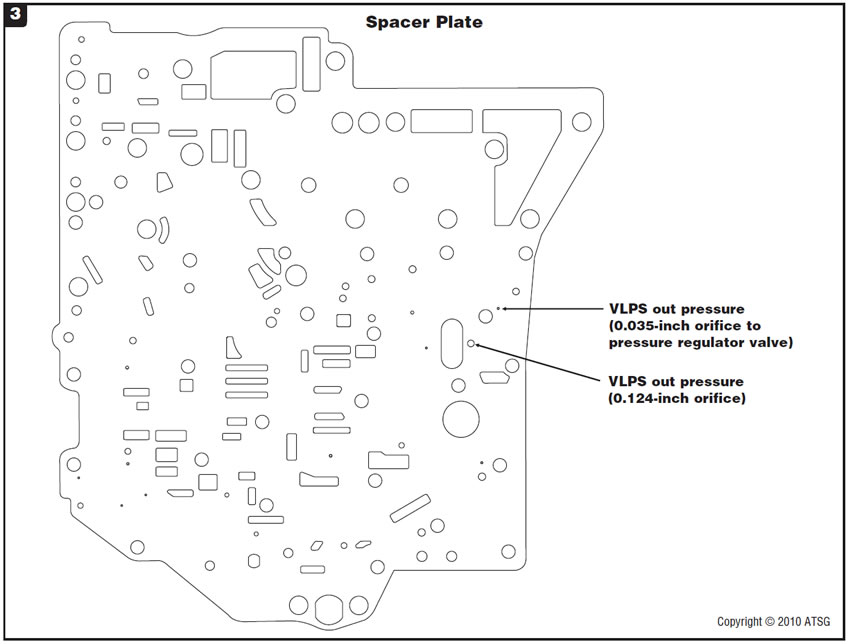
Transfer plate: Similar to the valve body, the casting of the transfer plate received changes to the hydraulic passages to accommodate the use of the added solenoid (Figure 4).


Pressure-regulator valve: The pressure-regulator valve was changed to a single anodized valve and spring arrangement.
Variable-line-pressure solenoid: The VLPS is a variable-force-style solenoid that is duty cycled to reduce line pressure. When the solenoid is off, it blocks pressure from passing through the solenoid. When it is duty cycled, pressure passes through the solenoid and acts on the end of the pressure-regulator valve to reduce line-pressure output (Figure 5).
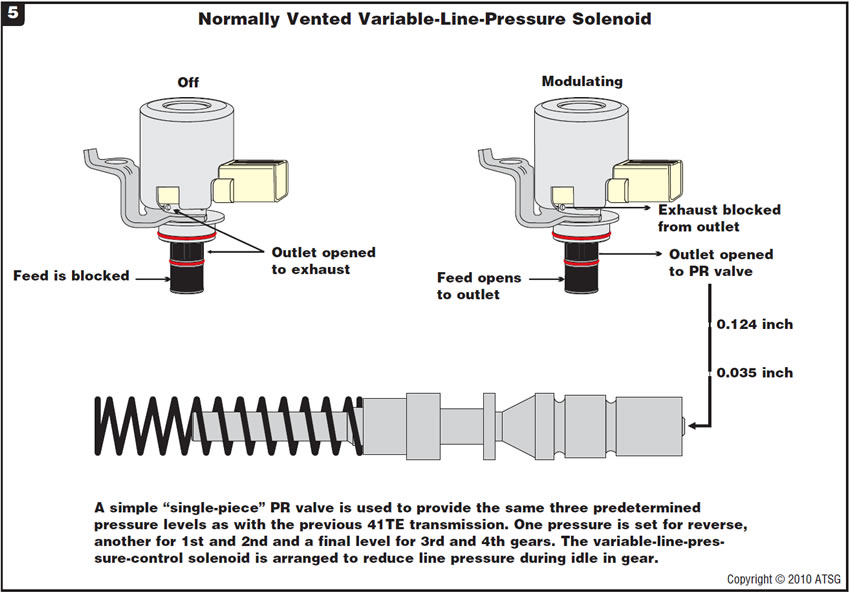
VLPS transducer: The VLPS transducer (line-pressure sensor – LPS) is the same style of transducer used in the 45RFE, 62TE and 42RE transmissions in that it is a three-wire sensor (5-volt supply, ground and signal) that monitors the activity of the VLPS via main line pressure (Figure 2). The information provided by this sensor to the PCM is also used by the PCM to tailor the solenoids’ operation.
Diagnostic codes: With the addition of the VLPS and transducer, additional diagnostic codes have been added to reflect failures related to these items. The codes added are as follows:
Code P0868 – Line Pressure Low
The PCM continuously monitors actual line pressure (the transducer signal – LPS) and compares it with desired line pressure (VLPS command). If the actual line pressure is more than 10 psi below desired line pressure, this DTC will set.
Possible Causes (no specific order):
- Check for related DTCs
- Low fluid level
- Transducer (LPS) 5-volts supply circuit open
- Transducer (LPS) 5-volts supply circuit shorted to ground
- Transducer (LPS) 5-volts supply circuit short to voltage
- VLPS control circuit shorted to another circuit
- Internal transmission failure
- Malfunctioning transducer (LPS)
- Malfunctioning VLPS
- Cracked, plugged or improperly installed primary oil filter
- Stuck or sticking pressure-regulator valve
- Malfunctioning PCM
Theory of operation
Line pressure is monitored by the transducer, and regulation is achieved by changing the duty cycle of the VLPS controlled by the transmission control system in the PCM. 5% duty cycle = solenoid off, which equals maximum line pressure. 62% duty cycle = solenoid on, which equals minimum line pressure. The transmission control system calculates the desired line pressure based on inputs from both engine load and transmission.
The transmission control system calculates torque input to the transmission and uses it as the primary input to the desired pressure calculation. This is called torque-based line pressure. In addition, the line pressure is set to a preset level of 827 or 931 kPa (120 or 135 psi) during shifts and in Park and Neutral to ensure consistent shift quality. The desired line pressure is continuously being compared with the actual line pressure. If the actual line pressure is consistently lower than the target while the vehicle is being driven, the line-pressure-low DTC P0868 will set.
Figures 6 through 8 provide hydraulics for Park, Drive 1st at idle and Drive 1st off idle.
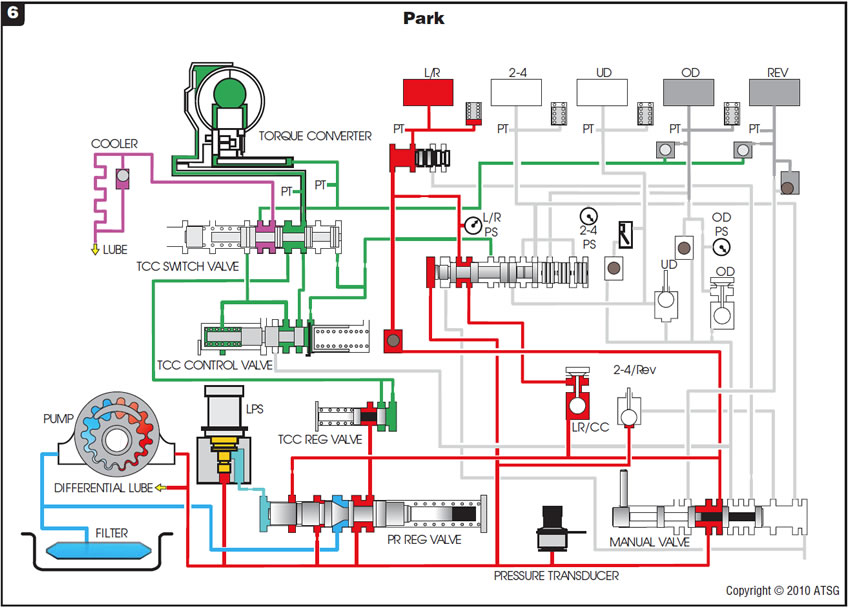
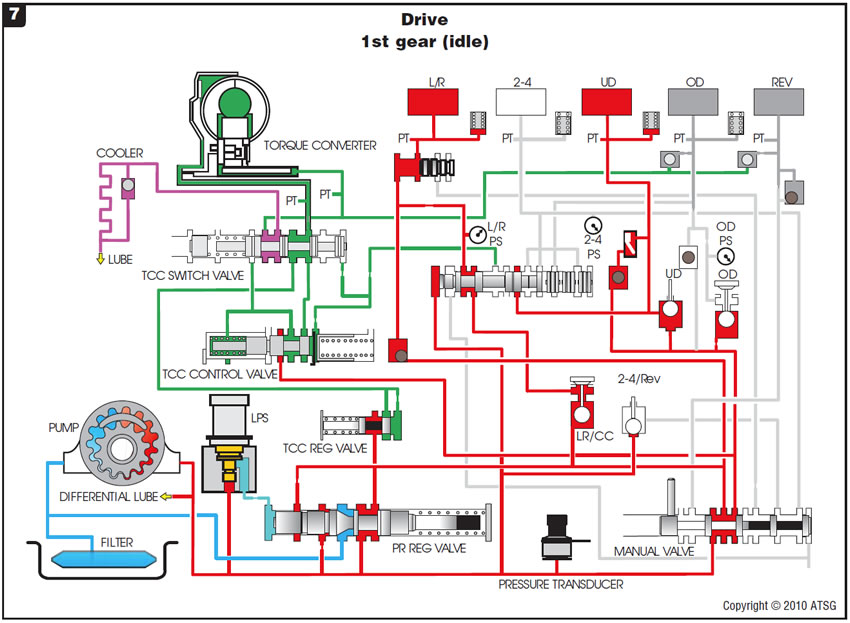
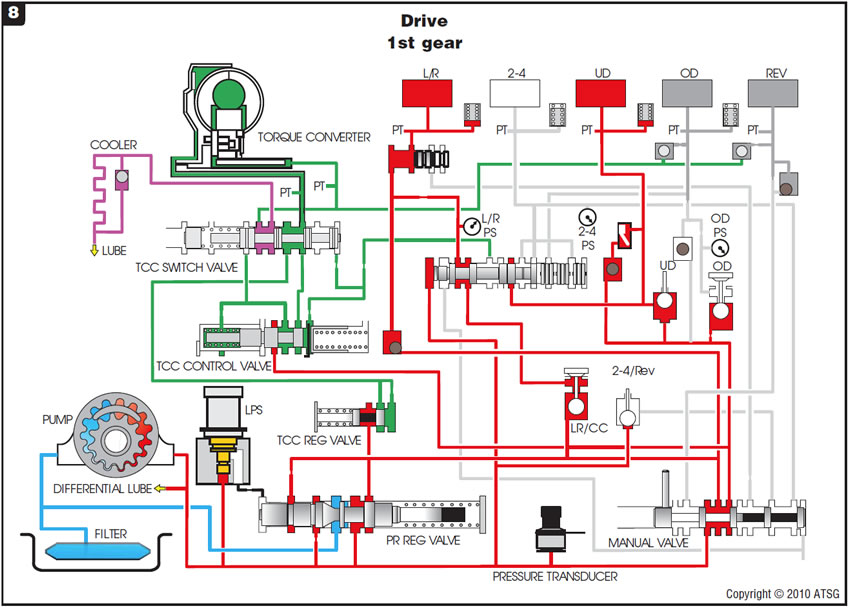


Related codes
Code P0869 – Line Pressure High
The PCM continuously monitors actual line pressure (the transducer signal). If the actual line-pressure reading is greater than the highest desired line pressure (VLPS command) ever used in the current gear, while the VLPS duty cycle is at or near maximum value (which should result in minimum line pressure), this DTC will set.
Possible causes (no specific order):
- Transducer (LPS) 5-volts supply circuit open
- Transducer (LPS) 5-volts supply circuit shorted to ground
- Transducer (LPS) ground circuit open
- Transducer (LPS) connection faulty
- Malfunctioning transducer (LPS)
- VLPS control circuit open
- Transmission control relay output circuit open
- Mechanical failure of the VLPS
- Stuck or sticking pressure-regulator valve
- Malfunctioning PCM
Theory of operation
Line pressure is measured by the transducer, and regulation is achieved by changing the duty cycle of the VLPS controlled by the transmission control system in the PCM. 5% duty cycle = solenoid off, which equals maximum line pressure. 62% duty cycle = solenoid on, which equals minimum line pressure. The transmission control system calculates the desired line pressure based on inputs from both engine load and transmission.
The transmission control system calculates torque input to the transmission and uses it as the primary input to the desired pressure calculation. This is called torque-based line pressure. In addition, the line pressure is set to a preset level of 827 or 931 kPa (120 or 135 psi) during shifts and in Park and Neutral to ensure consistent shift quality. The desired line pressure is continuously being compared with the actual line pressure. If the actual line pressure is consistently higher than the highest desired line pressure ever used in the current gear, the line-pressure-high DTC P0869 will set.
Code P0932 – Line Pressure Sensor Circuit
The PCM continuously monitors actual line pressure (the transducer signal) and compares it with the desired line pressure (VLPS command). If the actual line-pressure reading is more than 172.4 kPa (25 psi) higher than the desired line pressure but is less than the highest line pressure ever used in the current gear, DTC P0932 will set.
Possible causes (no specific order):
- Check for related DTCs
- Faulty VLPS connector and wiring
- Internal transmission failure
- Malfunctioning PCM
Theory of operation
Line pressure is electronically controlled by the transmission control system and is measured by the transducer (line pressure sensor – LPS). The desired line pressure is continuously being compared with the actual line pressure and is regulated electronically by changing the duty cycle of the VLPS. 5% duty cycle = solenoid off, which equals maximum line pressure. 62% duty cycle = solenoid on, which equals minimum line pressure.
The transmission control system calculates the desired pressure based on inputs from the transmission and engine. A calculated torque input to the transmission is used as the primary input of the desired line-pressure calculation and is called torque-based line pressure. In addition, the line pressure is set to a preset level of 827 to 931 kPa (120 to 135 psi) during shifts and in Park and Neutral to ensure shift quality.
Code P0934 – Line Pressure Sensor Circuit Low
The DTC will set when the monitored transducer (line pressure sensor – LPS) signal voltage is less than or equal to 0.35 volt for 0.18 second.
Possible causes (no specific order):
- Transducer (LPS) 5-volts supply circuit open
- Transducer (LPS) 5-volts supply circuit shorted to ground
- Transducer (LPS) signal circuit shorted to ground.
- Malfunctioning transducer (LPS)
- Malfunctioning PCM
Theory of operation
Line pressure is electronically controlled by the transmission control system and is measured by the transducer (line pressure sensor – LPS). The desired line pressure is continuously being compared with the actual line pressure and is regulated electronically by changing the duty cycle of the VLPS. 5% duty cycle = solenoid off, which equals maximum line pressure. 62% duty cycle = solenoid on, which equals minimum line pressure.
The transmission control system calculates the desired pressure based on inputs from the transmission and engine. A calculated torque input to the transmission is used as the primary input of the desired-line-pressure calculation and is called torque-based line pressure. In addition, the line pressure is set to a preset level of 827 to 931 kPa (120 to 135 psi) during shifts and in Park and Neutral to ensure shift quality.
The monitored transducer (LPS) signal voltage should always be between 0.35 and 4.75 volts. Any monitored voltages outside of these parameters indicate a faulty transducer or associated wiring and will cause DTC P0934 or P0935 to set.
Code P0935 – Line Pressure Sensor Circuit High
The DTC will set when the monitored transducer (line pressure sensor – LPS) signal voltage is greater than or equal to 4.75 volts for the period of 0.18 second.
Possible causes (no specific order):
- Transducer (LPS) sensor ground circuit open
- Transducer (LPS) signal circuit shorted to power
- Malfunctioning transducer (LPS)
- Malfunctioning PCM
Theory of operation
Line pressure is electronically controlled by the transmission control system and is measured by the transducer (line pressure sensor – LPS). The desired line pressure is continuously being compared with the actual line pressure and is regulated electronically by changing the duty cycle of the VLPS. 5% duty cycle = solenoid off, which equals maximum line pressure. 62% duty cycle = solenoid on, which equals minimum line pressure.
The transmission control system calculates the desired pressure based on inputs from the transmission and engine. A calculated torque input to the transmission is used as the primary input of the desired-line-pressure calculation and is called torque-based line pressure. In addition, the line pressure is set to a preset level of 827 to 931 kPa (120 to 135 psi) during shifts and in Park and Neutral to ensure shift quality.
The monitored transducer (LPS) signal voltage should always be between 0.35 and 4.75 volts. Any monitored voltages outside of these parameters indicate a faulty transducer or associated wiring and will cause DTC P0934 or P0935 to set.

None of the parts listed are interchangeable with previous models, nor are previous-model parts interchange-able with the new 41TES transmission.


December 2010 Issue
Volume 27, No. 12
- Chrysler/Dodge 41TES/42RLE-VLP: Variable-line-pressure solenoid and sensor

